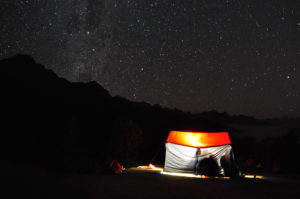By Katie Allie
These are my stories from the road and hard-won guidance from a thoughtful traveler. If I’m making you curious about getting lost and finding the good stuff in this great big world we all share, then I’m doing something right.
It took me about two days of gazing at a friend’s photos of UNESCO World Heritage site Machu Picchu in Peru before propositioning my sister to take the ancient path with me.
“We are going to hike the Inca Trail,” I told her. “You’d better start looking for some hiking boots.”
In the time since our successful trek, I have been approached by a number of people who want to do the same. In fact, a large number of those folks are fellow West Virginians, drawn to the rugged terrain and mysterious Incas. Most are not sure where to start. If this sounds like you, there are a few important things I think you should know.
Book early and be sure.
While there are a number of trekking options to get you to Macchu Pichu, if you want to hike the Inca Trail route, you’re going to need to book well in advance and be very sure of your dates. The Peruvian government heavily regulates the number of people who can be on the trail at any given time with a permit system, and usually those permits go on sale in January each year. Hikers must go with an approved operator, and once you choose dates, there are typically no refunds. We used Llama Path, and I highly recommend them. Don’t forget that the trail is closed every February for routine maintenance.
Take altitude sickness seriously.
 Most people who undertake the Inca Trail fly into Cusco, where they are immediately short of breath—and not because of the views. Altitude sickness is something you should take seriously, and it has absolutely nothing to do with your fitness level. It can be deadly, and the only way to remedy the situation if it becomes serious is to descend to a lower altitude. When you’re on the trail, that means a porter literally carrying you out. Before arriving, I talked to my doctor about a prescription medication that can lessen the effects of, and possibly prevent, altitude sickness. I also arrived in Cusco three days prior to our hike in order to acclimate and avoided those pisco sours. I definitely noticed a difference while I was in Peru, but my suffering from the altitude was minimal.
Most people who undertake the Inca Trail fly into Cusco, where they are immediately short of breath—and not because of the views. Altitude sickness is something you should take seriously, and it has absolutely nothing to do with your fitness level. It can be deadly, and the only way to remedy the situation if it becomes serious is to descend to a lower altitude. When you’re on the trail, that means a porter literally carrying you out. Before arriving, I talked to my doctor about a prescription medication that can lessen the effects of, and possibly prevent, altitude sickness. I also arrived in Cusco three days prior to our hike in order to acclimate and avoided those pisco sours. I definitely noticed a difference while I was in Peru, but my suffering from the altitude was minimal.
Dress appropriately.
So you’ve picked dates, put down a deposit and booked flights. Now it’s time for you to think about your gear. This is not the time to scrounge around for some old sneakers and a windbreaker. Invest some time and money in your gear so you’re not miserable or, worse yet, you find yourself needing to make an early exit from the trail.
I hiked in August, which was so dry my sister was getting nosebleeds. However, even with the absurdly sunny weather, the sun went down fast and rose late in the mountains, which meant layers were important. Peru has a dry season and a wet season—our hike would have been much different had we taken it in January, and even with the dry forecast, I packed a rain jacket just in case. I was always wearing a base layer, a long-sleeve light piece of fast-drying athletic wear and a heavier fleece. A hat and gloves also came in handy. As the day went on and I was moving—i.e., panting and sweating—I could remove the heavier gear.
Real hiking boots that you have broken in prior to your trip are an absolute must, along with thick socks. I cannot stress enough the importance of taking care of your feet. I also had comfortable, fast-drying pants and other layers I could put on at night when I snuggled into my compact but warm sleeping bag. Yes, all of this came with me on the plane.
Bring a daypack.
Take your hiking company up on the option to hire a porter for your big stuff. Everyone I’ve ever spoken with does.  This means you can carry a daypack to carry your eco-friendly, re-usable water bottles, snacks to keep up your energy, sunglasses, a rain jacket, bandages, passport, camera and chap stick—anything essential you cannot lose or may need during the day. There is an opportunity to purchase some snack items on the trail on the second day from local villagers that make the trek up the mountain, but don’t count on a cheap or amazing selection. You would be better advised to purchase these items in Cusco prior to your departure.
This means you can carry a daypack to carry your eco-friendly, re-usable water bottles, snacks to keep up your energy, sunglasses, a rain jacket, bandages, passport, camera and chap stick—anything essential you cannot lose or may need during the day. There is an opportunity to purchase some snack items on the trail on the second day from local villagers that make the trek up the mountain, but don’t count on a cheap or amazing selection. You would be better advised to purchase these items in Cusco prior to your departure.
Bring money to tip your porters and guides.
I feel like this should go without saying when you’re hiking through mountains on an ancient path, but I’ll go ahead and say it anyway: there are no ATMs. That porter who’s lugging all your stuff around while you’re heaving under the weight of a daypack? He’s also cooking your dinner, setting up and breaking down camp every day and probably even providing a little evening entertainment. I decided to hike with Llama Path in part because I saw that they attired their porters appropriately and appeared to treat them well, but tipping is expected and an important part of their livelihood. This means you will need to bring cash—Peruvian soles—and carry them with you during your trek. You will typically give your porters a tip as a group on the final night of the trek, as you will be awakened before dawn to make the final push to Machu Picchu. If you have questions about how much is expected, ask your operator at the pre-departure trip meeting you are likely to have in Cusco. Remember, banks are usually closed on Sundays.
Enjoy the journey.
This trip took a lot of preparation. We spent time seeking out affordable and functional gear, stressed over arrival and departure times, lifted weights to get in shape and more. Still, while this was one of the hardest physical and mental things I’ve ever done—don’t laugh—we still reminisce about it. Even though it was difficult and required planning, it’s completely feasible for regular people to make the hike. It was worth every ounce of blood, sweat and, yes, tears to conquer Dead Woman’s Pass together. I would even say it topped the moment we actually laid eyes on Machu Picchu. Live every moment of your hike because you’ll remember it for years to come.
 About the Author
About the Author
Katie Allie is a West Virginia native who holds degrees in English and elementary education. A teacher by trade, she spent years in a classroom before branching out as a travel consultant and writer. With five continents under her belt and an affinity for noodle soup, it should come as no surprise that she loves to write about food and talk adventure. She may be reached at hello@acrossthelinetravel.com, and you can read more about her adventures at www.wvexecutive.com/category/executive-exclusives.



1 Comment
You are so good at getting people to take good care of themselves. How about sharing a web link so I can see some photos of what I might see on the trail. Always enjoy reading your words Katie.. Auntie B